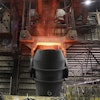
In the late 1990s, a major retailer with stores throughout the U.S. was experiencing a unique theft problem. It wasn’t customer thefts they were worried about, but thefts from their distribution centers around the country.
Here’s what was happening:
Trucks would be filled with merchandise at the distribution centers. But, by the time they got to their destination, much of that merchandise would be missing. The retailer assumed this was an “in-house” job, as are so many if not most thefts occurring from distribution sites. To address the issue, the company devised an easy fix.
Once the freight trucks were filled and an accounting was taken of all the merchandise loaded into the truck, the back doors of the cargo space would be sealed. That way, if the truck arrived at one of the stores with the seal broken — and merchandise was missing — it would be reasonably easy for the retailer and investigators to determine who the thieves were.
Sealing the truck doors worked — initially. But over time, trucks were arriving at stores with their seals intact but with a considerable amount of merchandise still missing.
How could this be happening?
Finding answers was proving difficult. Then, a “snitch” helped investigators figure it out. The drivers, in collusion with others involved with the thefts, were removing the back doors from their hinges without harming the seal. With the doors removed, the perpetrators took what they wanted, rehinged the doors, and went on their merry way, all without breaking the seal.
After this became known, the retailer continued sealing the back doors of their trucks, but now they went a step further. They welded the hinges so the doors could not be removed.
This happened long before GPS, which we will discuss later, and other electronic technologies were introduced to help prevent distribution thefts. While this is an old story, it is worth repeating, because it shows just how far criminals will go and why distribution organizations must continually think “outside the box” to prevent thefts in and from distribution center sites.
The following are some additional issues that distribution site owners and managers should be aware of:
- As discussed earlier, distribution center thefts are usually in-house operations involving one or more people working at the site — rarely is it just one person. In addition, collusion often happens with external thieves working with employees.
- In the old days, before the Internet, a go-between known as a “fence” would pay the culprits for the stolen goods. Today, most distribution center thieves sell the merchandise online, where there is extraordinarily little accountability. (See Sidebar: Tell Me More About a Fence)
- Although most distribution center thefts are in-house events, companies still must protect themselves from outside intruders. Perimeter alarm systems and CCTV cameras must be installed around the entire property.
- Access control is also imperative. Along with employees, most distribution centers allow visitors in their sites, including the truck drivers that are often sub-contractors. Knowing who is on the property, how they entered, where they are, and when they left, is critical information that must be documented.
GPS Tracking
While most of us use GPS (global positioning systems) to help us get from one place to another, GPS systems are now playing a very crucial role in preventing cargo thefts, as these systems are being used for tracking trucks. They tell distribution owners and managers the precise location of their drivers — and their merchandise — in real time/at any time.
Some distribution sites even go a step further. They place GPS devices in some of the packages being delivered. This way, they can track the truck and those specific packages, ensuring they both reach their designated destination.
This results in greater peace of mind for distributors, but it does one more thing as well. It acts as a deterrent. It puts everyone on notice that they and their merchandise are being monitored at all times.
Warning Signs
Even when GPS systems and other crime-prevention steps are in place, thefts at distribution centers are likely to continue. Perpetrators are continually finding new and more sophisticated ways to steal. No wonder, considering there is so much money involved.
In 2020, the National Insurance Crime Bureau estimated that cargo theft, as it is called, results in annual losses of as much as $35 billion in the U.S. Because of this, distribution site owners and managers should be aware of the warning signs that thefts may be unknowingly occurring. Among those warning signs are the following:
- Boxes of merchandise left at dock areas for no justifiable reason.
- Employees refusing to turn over specific job tasks to other workers, even when they are going on vacation.
- Employees who voluntarily work unusual hours or hours they are not assigned to work.
- Staffers who get defensive when asked to provide receipts or report on their work or deliveries.
- Having unexplained, all-of-a-sudden, close relationships with employees in other departments.
- Having a personal lifestyle that does not match their salary.
There are many more than can be listed. The bottom line when it comes to thefts in distribution locations is something we mentioned earlier: site owners and managers always should be looking outside the box. The ways merchandise was stolen years ago are likely not the ways it is being stolen today.
 Mike Keenan
Mike Keenan
Mike Keenan works with TAL Global a security and risk management firm based in Silicon Valley. His specialties are, loss prevention, retail security, and building and corporate security. He can be reached at: [email protected]























